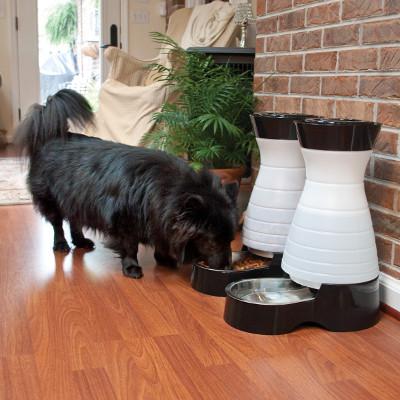By Dr. Patrick Mahaney, VMD
 Potential dog owners interested in adopting a large or giant pure or mixed-breed canine must make themselves aware of a severe, life-threatening ailment commonly affecting big-statured dogs. If you’ve seen the heart wrenching movie (or read the book) Marley & Me, you’re familiar with the scene where Luke Wilson informs Jennifer Aniston that their dog, Marley, is diagnosed with a “stomach twist.” In my clinical practice, I’ve been faced many times with the unfortunate task of alerting dog owners that their beloved canine has such a condition.
Potential dog owners interested in adopting a large or giant pure or mixed-breed canine must make themselves aware of a severe, life-threatening ailment commonly affecting big-statured dogs. If you’ve seen the heart wrenching movie (or read the book) Marley & Me, you’re familiar with the scene where Luke Wilson informs Jennifer Aniston that their dog, Marley, is diagnosed with a “stomach twist.” In my clinical practice, I’ve been faced many times with the unfortunate task of alerting dog owners that their beloved canine has such a condition.
Symptoms
This common canine crisis is called Gastric Dilatation Volvulus (GDV) or bloat, and occurs when the stomach takes a 180 (more common) or 360 degree (less common) twist inside the abdominal cavity. This leads to a combination of clinical signs prompting an owner to pursue emergency veterinary care, including but not limited to:
- Abdominal Distension. When the stomach twists, its contents (food, liquid, air, etc.) can’t properly exit into the small intestine. As a result, the stomach fills with gas and starts to distend. With the contents having no escape, the stomach’s maximum limits are reached and it can be felt or seen protruding beyond the dog’s last rib. This extreme dilation is termed dilatation. The distended stomach will feel firm to the touch and will have a tympanic or drum-like effect when tapped.
- Retching to Vomit. The twisted stomach prevents movement of fluid and food in the appropriate direction from the mouth, down the esophagus and into the stomach. Digesting food can’t move in the opposite direction from the stomach into the esophagus. Therefore, oral and esophageal secretions accumulate at the end portion of the esophagus right above the stomach (higher than the twist), and the dog will repeatedly retch thick, white, foamy liquid.
- Pacing or Restless Behavior. The dilatation of the stomach causes great discomfort. As a result, the affected dog exhibits pacing and restless behavior instead of lying down or sitting in an uncomfortable position.
- Pale Gums and Increased Heart Rate. GDV stops blood from returning from the lower body back to the heart, which can then causes the dog’s gums to appear pale. Heart rate increases in an attempt to push more blood flow to the front of the body. Extreme heart rate elevation can cause a dangerous cardiac arrhythmia (abnormal rhythm) called Ventricular Premature Contraction (VPC).
Not all dogs will develop GDV. Additionally, not all canines having the characteristics of a GDV-prone patient will suffer from the condition. It’s best for owners of large dog to be aware of the physical and behavioral factors that correlate with GDV, including:
- Large and Giant Body Size. GDV is most often seen in large and giant sized dogs. Such substantial canines often have a deep chest and a narrow waist, which is theorized to permit more free space in the upper abdominal cavity for the stomach to twist.
- Advanced Age. Adults and senior dogs are more commonly afflicted with GDV than younger dogs. The reason behind this isn’t known.
- Eating and Drinking Habits. Your dog may be at risk if he: gulps food, doesn’t chew food properly, eats primarily dry kibble, binge eats large amounts of food or garbage, drinks lots of water after eating, or exercises shortly before or after eating or drinking. A full stomach creates a centripetal effect permitting torsion (twist).
When it comes to GDV and dogs, prevention is truly the best medicine. Slow down the pace of your dog’s eating and drinking. Feed your dog in a special bowl or food-dispensing toy designed to slow down eating, or place a tennis ball in his dish to make him eat his way around it to get the food. Instead of consuming kibble, feed your dog a whole food diet containing small pieces of real meat, vegetables, fruits and other ingredients. Wait at least an hour before or after exercise to feed your dog. Limit the amount of water consumed before, during, and after exercise and eating.
Treatment
GDV is always a life threatening condition. If you suspect your dog has bloat, immediately seek medical care with your veterinarian or an emergency veterinary facility. An exploratory abdominal surgery is needed to relieve the torsion, evaluate the other organs for associated abnormalities, and surgically attach the stomach in a normal position to the body wall (gastropexy). To take a truly preventative approach, any “bloat-size” dog undergoing surgery, such as for a spay/neuter, can also have the gastropexy procedure performed at the same time to prevent torsion. Gastropexy can be performed at any life stage to reduce the likelihood that large dogs will develop GDV. Talk to your vet about this option for your large dog.




